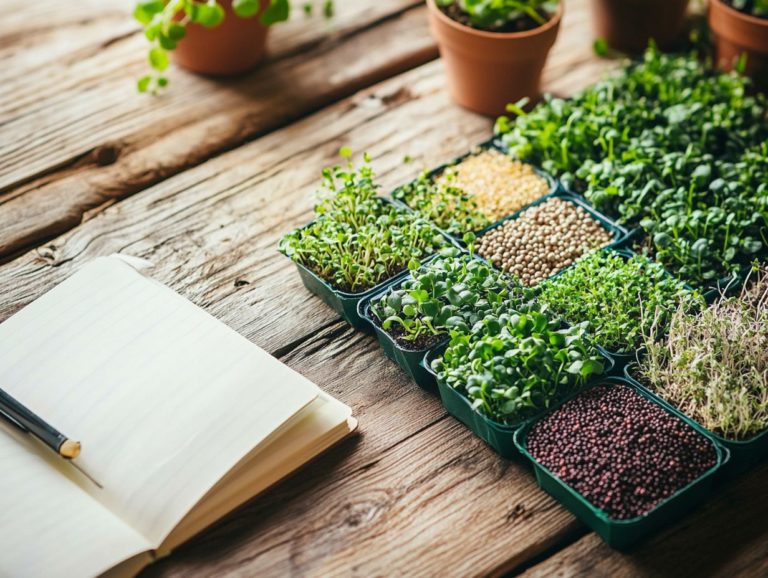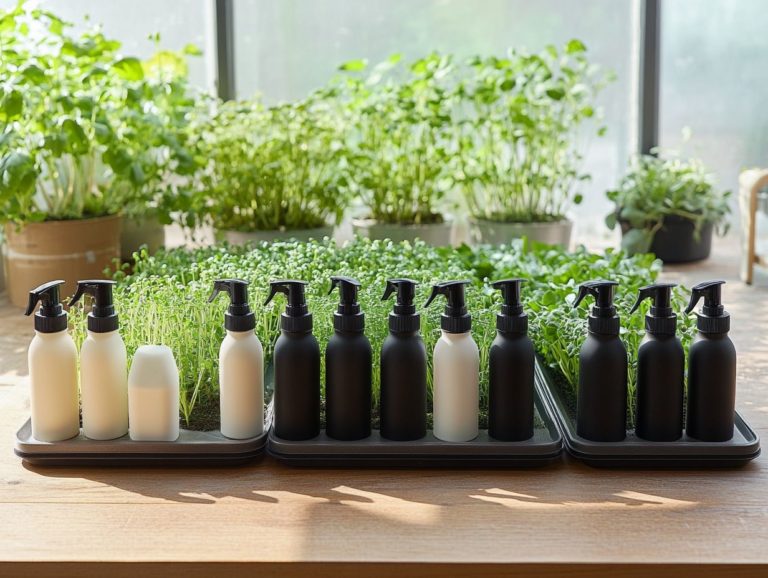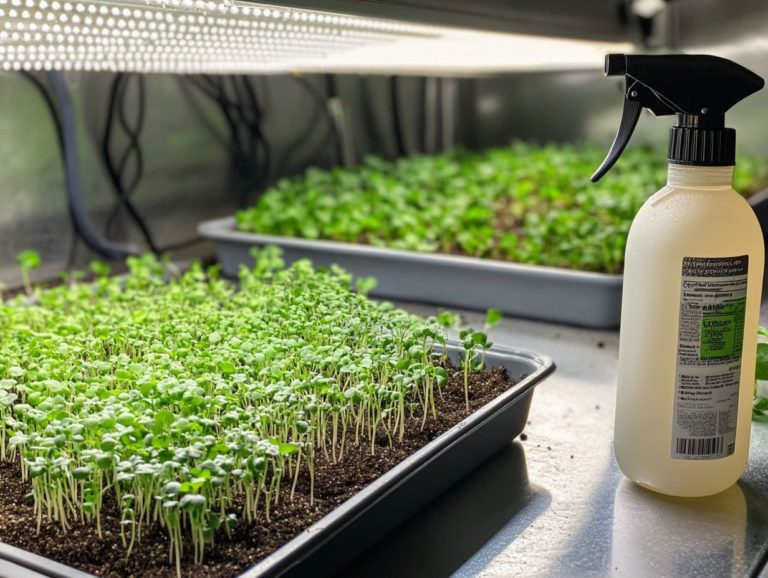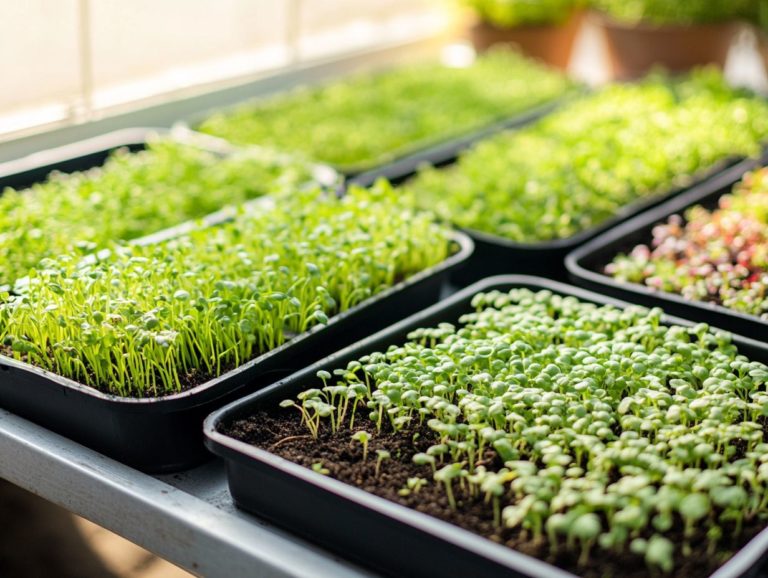Top 10 Hydroponic Systems for Microgreens
Hydroponics has revolutionized the way you grow plants, particularly microgreens. This method allows for quicker growth and greater yields without the need for traditional soil.
This article delves into the top 10 hydroponic systems specifically designed for microgreens. You will find options ranging from the straightforward Basic Tray System to the cutting-edge Aeroponics method.
Discover the myriad benefits of hydroponics, essential factors to consider when selecting the right system for your needs, and invaluable tips tailored for beginners. It will also highlight common pitfalls to avoid and the disadvantages to keep in mind.
Ready to transform your microgreen gardening? Let s dive into the exciting world of hydroponics!
Contents
- Key Takeaways:
- 1. Basic Tray System – An Example of User-Friendly Systems
- 2. Vertical Tower System
- 3. Nutrient Film Technique System
- 4. Ebb and Flow System
- 5. Drip System
- 6. Wick System
- 7. Deep Water Culture System
- 8. Aeroponics System
- 9. Aquaponics System – Embracing Innovative Methods
- 10. Hybrid System
- What Are Hydroponic Systems and How Do They Work?
- What Are the Benefits of Using Hydroponic Systems for Microgreens?
- What Factors Should Be Considered When Choosing a Hydroponic System for Microgreens?
- How Can a Beginner Get Started with Hydroponic Systems for Microgreens?
- What Are the Common Mistakes to Avoid When Using Hydroponic Systems for Microgreens?
- Are There Any Disadvantages of Using Hydroponic Systems for Microgreens?
- Frequently Asked Questions
- What are the top 10 hydroponic systems for microgreens?
- What factors should I consider when choosing a hydroponic system for microgreens?
- Can I use any hydroponic system to grow microgreens?
- Do I need any special equipment for a hydroponic system for microgreens?
- What are the advantages of using a hydroponic system for growing microgreens?
- Are hydroponic systems for microgreens suitable for beginners?
Key Takeaways:

- Choosing the right hydroponic system is crucial for successful microgreen growth.
- Some popular hydroponic systems for microgreens include the Basic Tray System, Vertical Tower System, and Nutrient Film Technique System.
- Factors to consider when choosing a hydroponic system include space, budget, and the type of microgreens being grown.
1. Basic Tray System – An Example of User-Friendly Systems
The Basic Tray System serves as the perfect gateway to hydroponics. It is ideally suited for home gardening enthusiasts who value effortless functionality and minimal water circulation.
Its straightforward setup makes it an excellent choice for anyone stepping into the world of indoor plant cultivation. Crafted from high-quality materials, this system promises durability that will endure both time and frequent use.
Its versatile design accommodates a wide range of plant varieties, from fragrant herbs to vibrant leafy greens, supporting your diverse gardening aspirations. What sets this system apart is its remarkable ability to boost plant growth through efficient nutrient delivery and optimized light utilization.
Users consistently rave about the simplicity and intuitiveness of the setup process, with many commending the clear instructions. This system has quickly become a favorite for both beginners and seasoned gardeners.
2. Vertical Tower System
The Vertical Tower System is your go-to hydroponic solution, designed to maximize space efficiency in indoor farms. It is perfect for growing the herbs and microgreens you love.
This innovative approach allows you to grow a high capacity of various plant varieties, while keeping maintenance simple and hassle-free for urban gardening enthusiasts. Utilizing cutting-edge vertical farming techniques, this system transforms even the most limited urban spaces into vibrant green sanctuaries.
Its sleek design and modular components not only enhance modern aesthetics but also optimize nutrient delivery. This means that even with your bustling lifestyle, you can enjoy fresh produce right at your fingertips.
The compact footprint promotes biodiversity, allowing a diverse range of plant varieties to thrive in the heart of the city. This ultimately fosters sustainability and well-being among urban dwellers, making it ideal for urban farming.
3. Nutrient Film Technique System
The Nutrient Film Technique (NFT) System is a sophisticated hydroponic method that uses a thin film of nutrient-rich water. This allows you to achieve optimal plant growth and efficient seed germination.
This innovative system creates a delicate film of water that envelops the roots, ensuring they receive a consistent supply of essential nutrients without the risk of waterlogging. By maintaining a steady flow, you enhance nutrient dispersion and facilitate vital oxygen exchange, crucial for root respiration.
Managing the pH levels in your nutrient solution is essential, as it directly impacts nutrient availability to your plants. A well-regulated pH ensures that essential minerals are readily absorbed, promoting robust growth and bolstering overall plant health.
As a result, indoor gardeners who embrace this technique often find themselves rewarded with thriving plants and bountiful harvests.
4. Ebb and Flow System
The Ebb and Flow System, often referred to as the flood and drain system, masterfully blends water reservoir management with plant nutrients, creating a vibrant environment that promotes robust plant growth a favorite among indoor gardeners who appreciate easy maintenance.
This cutting-edge approach operates on a cyclical flooding and draining mechanism. Water periodically envelops the roots, delivering essential nutrients, and then drains away, allowing the roots to breathe. This process maximizes oxygen uptake and prevents root rot, making it an ideal choice for various crops.
You ll find it easy to assemble, crafted from durable materials like PVC and food-grade plastics, making it accessible for gardeners of every skill level. With its efficient design, the system enhances plant health and boosts productivity, enabling faster growth and higher yields in any indoor garden.
5. Drip System
The Drip System stands out as a highly efficient hydroponic method, delivering precise amounts of plant food directly to the roots. It’s an exceptional choice for home gardening enthusiasts like you who desire easy maintenance and reliable performance.
This innovative system operates on a carefully planned watering schedule, ensuring each of your plants receives consistent hydration without the risk of over-saturation. By releasing water and nutrients in controlled bursts, it encourages healthier root development, fostering robust growth and ultimately leading to higher yields.
Users consistently report significant improvements in plant vitality and crop quality, often sharing their satisfaction in glowing reviews. You ll likely appreciate how this system reduces water waste and cuts down on the time you spend on garden upkeep, making it a perfect fit for busy gardeners who wish to maximize their efforts with minimal hassle.
6. Wick System
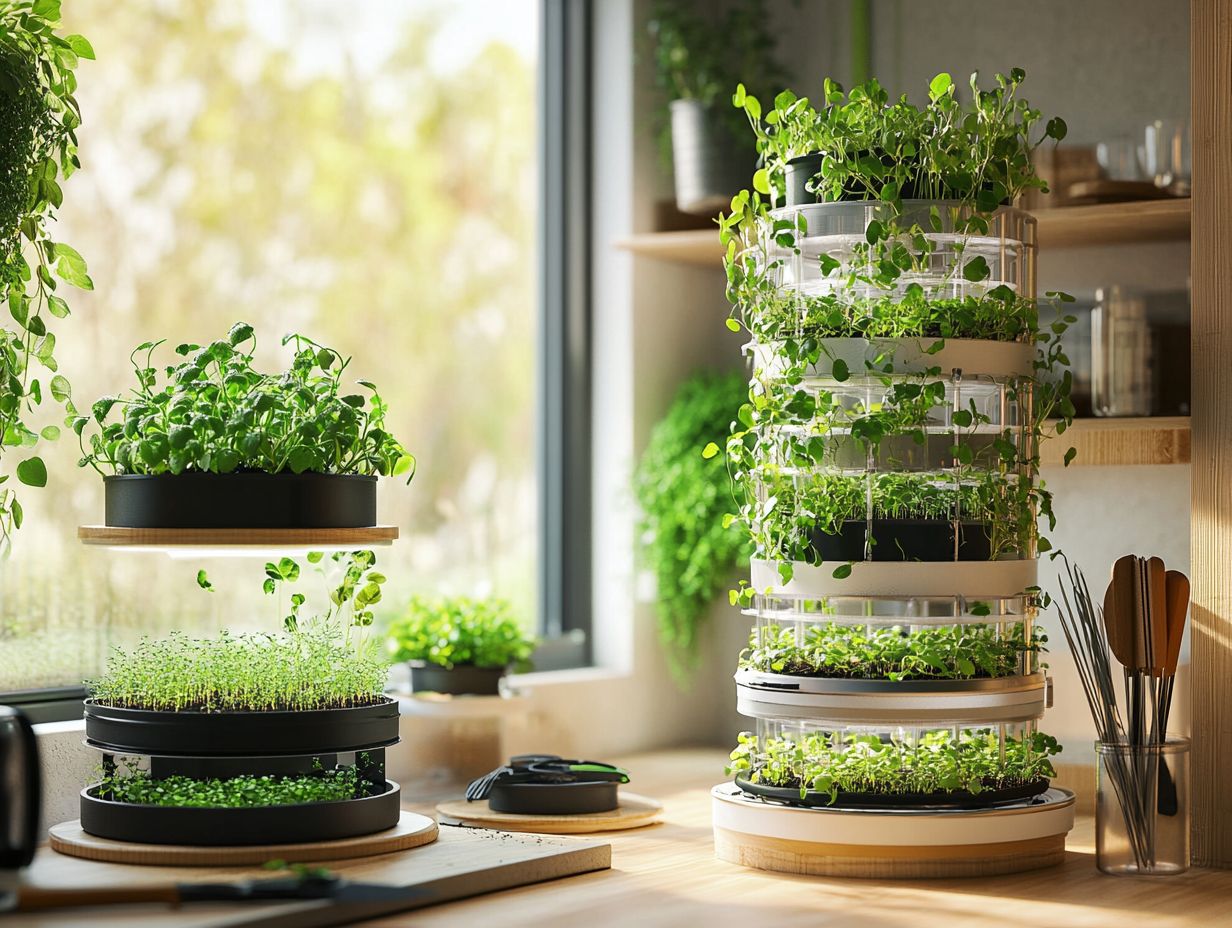
The Wick System offers a passive hydroponic method that utilizes simple wicking actions to deliver water and nutrients to your plants, making it an affordable and easy-to-set-up option for growing herbs and microgreens. Imagine the joy of seeing your herbs flourish!
This innovative approach removes the complexities that often accompany traditional hydroponics, enabling you to cultivate a variety of plants with minimal investment and effort, perfect for those using seed plugs or seed pods. Ideal candidates for this system include:
- Spinach
- Lettuce
And vibrant herbs such as:
- Basil
- Cilantro
With its ability to maintain consistent moisture levels, the Wick System ensures your plants thrive without the constant attention that other methods typically demand. Embracing this technique not only makes gardening more enjoyable but also promotes healthier plants through efficient, passive watering all without requiring extensive technical knowledge.
7. Deep Water Culture System
The Deep Water Culture (DWC) System is a standout hydroponic method that immerses your plant roots in a nutrient-rich water reservoir. This setup ensures exceptional oxygenation and fosters rapid growth, especially for those robust crops you re aiming to cultivate.
This technique also enables your roots to access all the essential nutrients and oxygen they need for optimal development. By using devices that add oxygen to the water, the system ensures your roots are continuously supplied with everything they require to thrive.
In this environment, a variety of plants can flourish, and you ll see great results with leafy greens such as lettuce and herbs like basil. To maximize your success, it s crucial to select high-quality materials for the reservoir and support structures. Doing so can significantly enhance your system’s efficiency and longevity, ultimately leading to bountiful harvests that you’ll be proud to share.
Start your hydroponic journey today and see the difference!
8. Aeroponics System
The Aeroponics System is a sophisticated method of growing plants without soil. It uses a misting method to deliver nutrients directly to the exposed roots, fostering exceptional growth while promoting sustainable farming.
This approach reduces reliance on soil and maximizes efficiency, cutting down water usage significantly compared to traditional farming methods. By using a fine mist to nourish the roots, you ensure optimal oxygen exposure, promoting robust health and resilience in your plants.
Additionally, this cutting-edge technology accelerates growth cycles and enables year-round cultivation regardless of weather. Its reduced dependency on water highlights its role in conserving vital resources, making it a key player in the shift towards sustainable and environmentally friendly agricultural practices.
9. Aquaponics System – Embracing Innovative Methods
The Aquaponics System merges fish farming with plant cultivation, creating a sustainable nutrient cycle. This system not only promotes healthy plant growth but also conserves water and reduces environmental impact.
This method enhances plant health by providing vital nutrients from fish waste while maintaining a balanced ecosystem where both fish and plants thrive. By incorporating fish species like tilapia or catfish alongside greens such as lettuce, herbs, and tomatoes, you cultivate a symbiotic relationship that boosts productivity.
This interconnected system minimizes the need for synthetic fertilizers and decreases reliance on freshwater. It positions aquaponics as a compelling solution for sustainable agriculture, whether in indoor farms, urban areas, or rural locations.
10. Hybrid System
The Hybrid System combines various hydroponic methods to provide a versatile solution for indoor gardening. You can tailor your approach based on the specific needs of different plant varieties.
By integrating techniques like nutrient film technique (NFT) and deep water culture (DWC), this innovative system optimizes nutrient access and growth rates. Each plant receives the right amount of water and nutrients, ensuring consistent yields throughout the seasons. Additionally, utilizing the top 10 microgreen lighting solutions can enhance growth and productivity.
Users often highlight reduced maintenance efforts and noticeable improvements in plant health. These benefits demonstrate how this system can elevate your indoor gardening experience, whether you re a novice or a seasoned grower.
What Are Hydroponic Systems and How Do They Work?
Hydroponic systems provide an exciting way to engage in indoor gardening. Instead of using soil, you grow plants in nutrient-rich water, utilizing advanced water circulation techniques to enhance growth and yield.
These systems rely on principles of nutrient absorption and precise environmental controls. They create optimal growth conditions that traditional soil gardening often struggles to achieve. With a variety of hydroponic setups available like nutrient film technique (NFT), deep water culture (DWC), and aeroponics, you can choose the system that best suits your space and desired crops. For those looking to expand their growing options, exploring the top 5 greenhouses for microgreen growing can provide valuable insights.
One of the most compelling advantages of hydroponics is its remarkable efficiency in water usage. In fact, it can require up to 90% less water than conventional farming methods, making it a sustainable option, especially in regions facing water shortages.
What Are the Benefits of Using Hydroponic Systems for Microgreens?
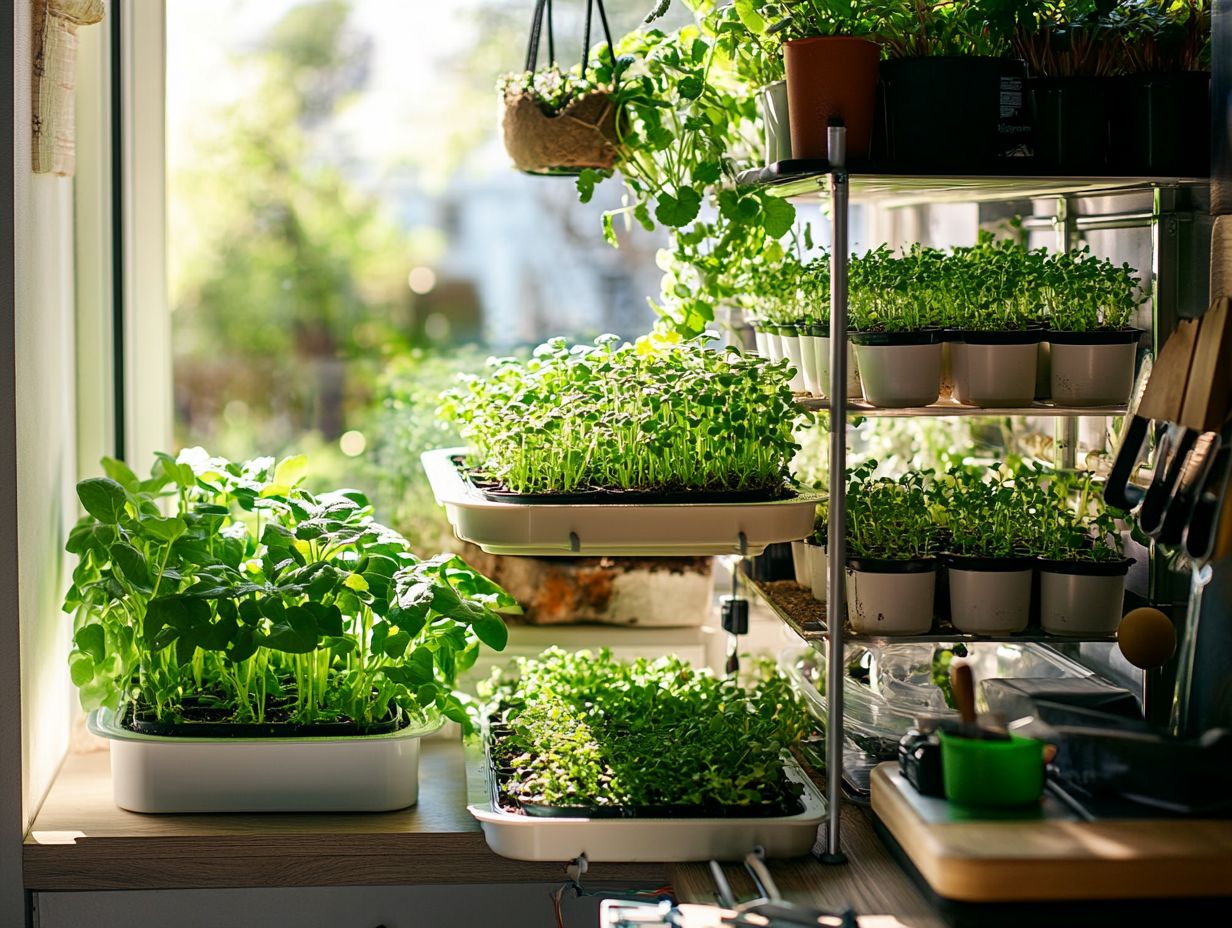
Using hydroponic systems to grow microgreens offers numerous advantages, such as faster growth cycles and enhanced nutrient content. These systems create optimal conditions that yield healthier, more vigorous crops compared to traditional soil methods, making them ideal for a home kitchen garden.
This innovative method not only speeds up growth by supplying a constant flow of nutrients directly to the roots but also reduces the risk of soil-borne pests and diseases that often affect traditional gardening. By managing light, temperature, and humidity, you can create a perfect environment tailored to the needs of various microgreens, supported by the top 5 microgreen support systems.
Popular choices like basil, radish, and sunflower thrive in these setups, providing vibrant flavors and exceptional nutrition due to their efficient mineral absorption. For those interested in enhancing their hydroponic experience, exploring the top 5 automated systems for microgreens can be an effective way to maximize productivity while promoting sustainability.
What Factors Should Be Considered When Choosing a Hydroponic System for Microgreens?
When selecting a hydroponic system for growing microgreens, consider key factors such as space requirements, type of system, plant support, and lighting options. These elements ensure your system is user-friendly and effectively supports your gardening goals.
Space is often crucial, especially in urban areas where room is limited. Different hydroponic systems, like nutrient film technique (a method that uses a thin film of nutrient solution) or deep water culture (where plant roots are suspended in nutrient-rich water), have varying spatial needs and growth capacities. To ensure optimal results, consider using the top microgreen sprayers for even watering. The right support mechanisms can greatly enhance your yield by providing stability for delicate plants.
Choosing the correct lighting system is also vital; the right spectrum and intensity of light can significantly impact plant growth, boosting photosynthesis and overall vitality. By considering these factors and using the top 10 must-have microgreen supplies, you can cultivate a thriving microgreens garden that truly flourishes.
How Can a Beginner Get Started with Hydroponic Systems for Microgreens?
If you’re a beginner eager to explore hydroponic systems for microgreens, focus on simple setup techniques and effective seed germination methods. Ensure sufficient plant support to create a thriving indoor garden with easy assembly.
Choosing a user-friendly hydroponic system, like a Kratky method (a passive system) or an Ebb and Flow system (which periodically floods the grow tray), simplifies your gardening journey while delivering impressive results. For those just starting, exploring top microgreen kits for beginners can provide the perfect setup.
Before planting, prepare the germination environment. Using a sterile medium and maintaining proper moisture levels can significantly enhance your success rates. Incorporating plant support like adjustable trellises or netting will help your delicate greens thrive without added stress.
Regularly checking on your plants ensures everything runs smoothly, making the gardening process more enjoyable and efficient.
What Are the Common Mistakes to Avoid When Using Hydroponic Systems for Microgreens?
Common mistakes include improper nutrient management, neglecting the watering schedule, and overlooking lighting conditions. Each can jeopardize plant health and yield, especially if you don’t monitor pH levels regularly.
Understanding these essentials can significantly improve your success rates. It’s crucial to monitor nutrient levels closely; an imbalance can lead to deficiencies or toxicities that stunt growth.
Establishing a consistent watering routine is key to preventing stress on young plants and fostering robust root development. Even experienced growers sometimes underestimate the importance of proper lighting, which is essential for photosynthesis. Without adequate light, even the best-managed nutrients may not yield healthy, vibrant microgreens.
By focusing on these critical factors, you can avoid common pitfalls and cultivate flourishing crops.
Are There Any Disadvantages of Using Hydroponic Systems for Microgreens?
Hydroponic systems offer many benefits for growing microgreens. However, they come with some drawbacks you should consider.
These drawbacks include higher initial costs, a steep learning curve, and ongoing maintenance that requires your attention. Such factors can deter novice gardeners, who often find traditional methods more accessible and budget-friendly.
The upfront investment in equipment, nutrient solutions, and technology can be significant. This contrasts sharply with the minimal setup required for soil gardening.
Mastering the balance of water acidity and the amount of nutrients in a hydroponic system requires expertise. Conversely, traditional gardens face pests and unpredictable weather but typically need less constant oversight.
Frequently Asked Questions
What are the top 10 hydroponic systems for microgreens?
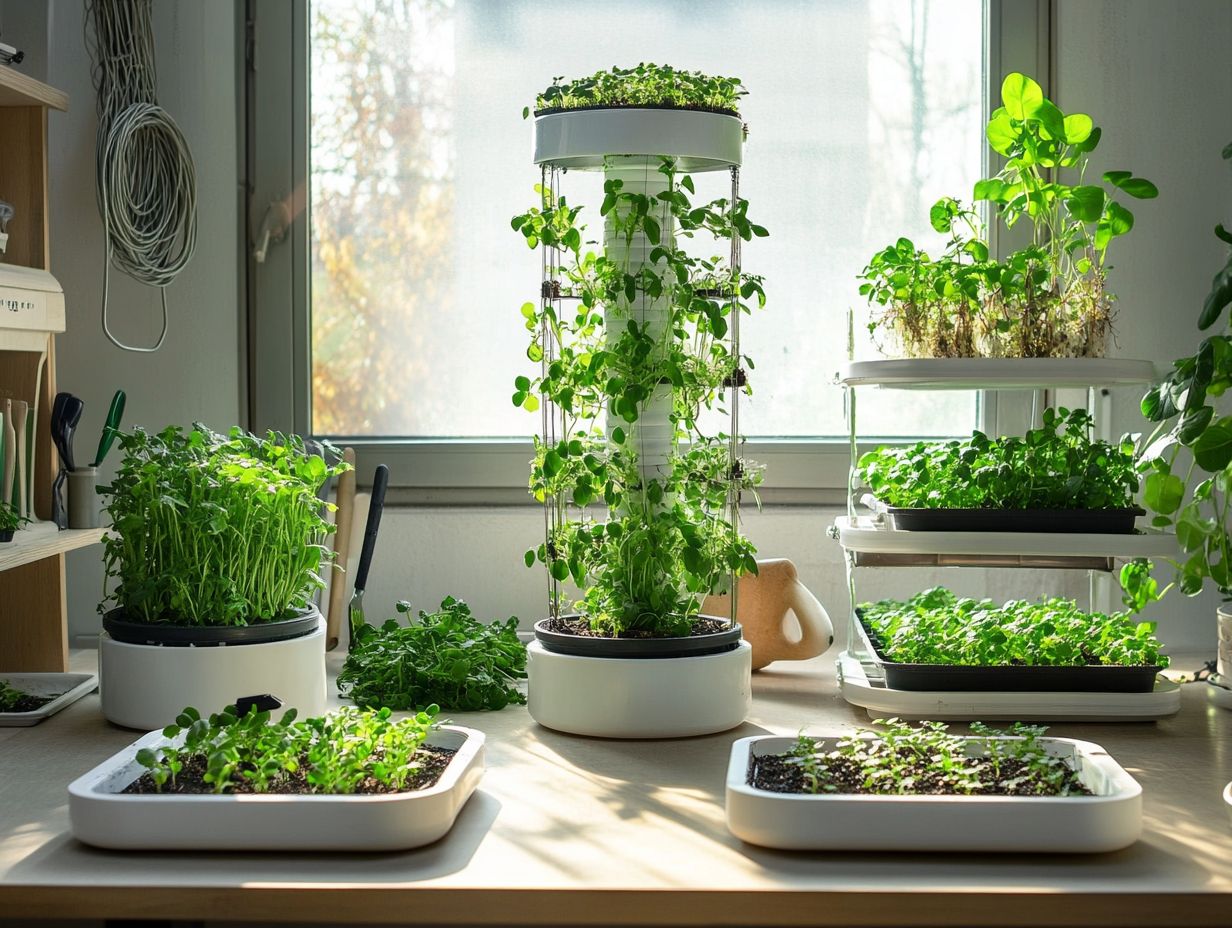
- AeroGarden Bounty
- Ebb and flow system
- Drip system
- Nutrient film technique (NFT) system
- Deep water culture (DWC) system
- Wick system
- Vertical tower system
- Aquaponics system
- Hybrid hydroponic system
- Lettuce Grow Farmstand
What factors should I consider when choosing a hydroponic system for microgreens?
Consider your budget, available space, and preferred growing method. Your experience level and the specific needs of the microgreens you want to grow are also crucial.
Can I use any hydroponic system to grow microgreens?
Yes, you can technically use any hydroponic system. Still, some systems are more effective for growing microgreens. Choose one that ensures proper aeration, water flow, and nutrient delivery for the best results.
Do I need any special equipment for a hydroponic system for microgreens?
You ll need essential equipment like a reservoir, pumps, tubing, and grow trays. Depending on your system, you may also need specific tools like an air pump for aeroponic systems or grow lights for indoor setups.
What are the advantages of using a hydroponic system for growing microgreens?
Hydroponic systems promote faster growth and higher yields. They also allow better control over nutrient delivery and are perfect for small spaces. Plus, they use less water and reduce the risk of pests and diseases compared to traditional methods.
Are hydroponic systems for microgreens suitable for beginners?
Yes! Hydroponic systems can be beginner-friendly if you start with simple, easy-to-use models. Research the basics and begin with a small system to gain experience before moving to larger setups.

